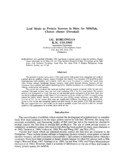Potential of feed pea (Pisum sativum) meal as a protein source in practical diets for milkfish (Chanos chanos Forsskal)
| dc.contributor.author | Borlongan, Ilda G. | |
| dc.contributor.author | Eusebio, Perla S. | |
| dc.contributor.author | Welsh, Tim | |
| dc.date.accessioned | 2014-03-25T08:12:57Z | |
| dc.date.available | 2014-03-25T08:12:57Z | |
| dc.date.issued | 2003 | |
| dc.identifier.citation | Borlongan, I. G., Eusebio, P. S., & Welsh, T. (2003). Potential of feed pea (Pisum sativum) meal as a protein source in practical diets for milkfish (Chanos chanos Forsskal). Aquaculture, 225(1-4), 89-98. | en |
| dc.identifier.issn | 0044-8486 | |
| dc.identifier.uri | http://hdl.handle.net/10862/1954 | |
| dc.description.abstract | A 12-week feeding trial was conducted to evaluate the use of feed pea meal as a dietary protein source for juvenile milkfish. Six isonitrogenous (30% crude protein) and isocaloric (16.5 kJ/g) practical diets were formulated. The control diet contained fish meal, soybean meal, meat and bone meal and copra meal as principal protein sources. Feed pea meal was progressively substituted at 0%, 5%, 10%, 15%, 20%, 25% and 30% of total protein. A leading commercial milkfish feed was also tested as an additional control. The experimental diets were fed to triplicate groups of milkfish fingerlings (mean initial weight of 0.42±0.01 g) at 10% body weight/day. Growth performance (expressed as percentage of weight gain and SGR), survival, feed conversion ratio (FCR) and protein efficiency ratio (PER) of milkfish fed diets with up to 10% substitution of the dietary protein with feed pea meal were not significantly different (P>0.05) compared to fish fed the control diet. Replacement with feed pea meal at 15% and higher levels led to milkfish fed these diets showing a significantly lower growth response compared to fish fed with the control without any feed pea meal. Nevertheless, it was observed that milkfish fed diets with up to 20% of total dietary protein substitution with feed pea meal showed better growth rates and feed conversion ratios than the commercial feed control. Whole body composition (crude protein, crude fat, crude fiber, nitrogen-free extracts and ash content) of milkfish fed the various test diets was not significantly different. Apparent digestibility coefficients of feed pea meal and experimental diets in milkfish were also determined. Results indicate that feed pea meal is an acceptable protein source and can replace up to 20% of the total dietary protein in milkfish diets. | en |
| dc.description.sponsorship | The authors gratefully acknowledge the United States Department of Agriculture (USDA) through the USA Dry Peas and Lentil Council (USADPLC), Moscow, ID, USA for funding support. The excellent technical assistance of Lucia Jimenez and Niel Tibubos is also appreciated. | en |
| dc.language.iso | en | en |
| dc.publisher | Elsevier | en |
| dc.subject | Chanos chanos | en |
| dc.subject | Pisum sativum | en |
| dc.subject | milkfish | en |
| dc.title | Potential of feed pea (Pisum sativum) meal as a protein source in practical diets for milkfish (Chanos chanos Forsskal) | en |
| dc.type | Article | en |
| dc.identifier.doi | 10.1016/S0044-8486(03)00280-1 | |
| dc.citation.volume | 225 | |
| dc.citation.issue | 1-4 | |
| dc.citation.spage | 89 | |
| dc.citation.epage | 98 | |
| dc.citation.journalTitle | Aquaculture | en |
| seafdecaqd.library.callnumber | VF SJ 0747 | |
| seafdecaqd.databank.controlnumber | 2003-19 | |
| dc.subject.asfa | body condition | en |
| dc.subject.asfa | diet | en |
| dc.subject.asfa | digestibility | en |
| dc.subject.asfa | aquaculture feeds | en |
| dc.subject.asfa | feed composition | en |
| dc.subject.asfa | feeding experiments | en |
| dc.subject.asfa | feed conversion efficiency | en |
| dc.subject.asfa | growth rate | en |
| dc.subject.asfa | proteins | en |
| dc.subject.asfa | survival | en |
| dc.subject.asfa | fishmeal | en |
| dc.subject.scientificName | Chanos chanos | |
| dc.subject.scientificName | Pisum sativum | en |
| local.subject | Aquaculture feeds | en |
| local.subject | Alternative protein source | en |
| local.subject | Feed pea (Pisum sativum) | en |
| local.subject | Meal | en |
| local.subject | Milkfish (Chanos chanos Forsskal) | en |
このアイテムのファイル
| ファイル | サイズ | フォーマット | 閲覧 |
|---|---|---|---|
|
このアイテムに関連するファイルは存在しません。 |
|||
このアイテムは次のコレクションに所属しています
-
Journal Articles [1256]
These papers were contributed by Department staff to various national and international journals.



